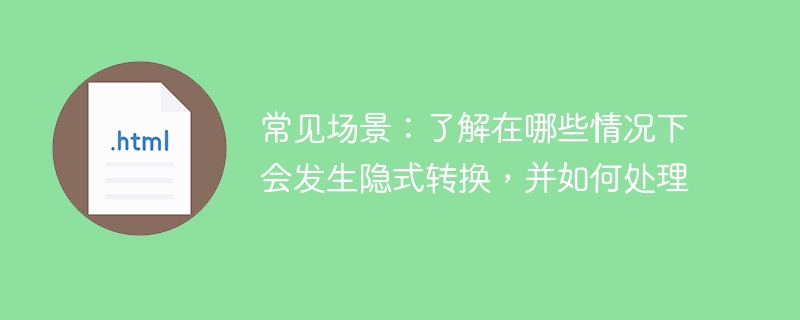

Common scenarios: Master the conditions and processing methods for implicit conversions,需要具体代码示例
隐式转换是编程中常见的一种类型转换方式,它可以自动将一个类型的值转换为另一个类型的值,从而方便我们处理不同类型之间的数据。在编程过程中,我们需要了解在哪些情况下会发生隐式转换,并学会如何处理它们。本文将介绍一些常见的场景,并给出具体的代码示例。
在数值计算中,不同类型的数值之间可能需要进行转换。比如,将一个整数转换为浮点数、将一个浮点数转换为整数等。下面是一个示例:
x = 3 y = 4.5 result = x + y print(result) # 输出 7.5,x 在加法运算中被隐式转换为浮点数 result = int(y) print(result) # 输出 4,将浮点数 y 转换为整数
字符串和数值之间的隐式转换也是常见的场景。比如,将一个数值转换为字符串、将一个字符串转换为数值等。下面是一个示例:
x = 3 y = "4" result = str(x) + y print(result) # 输出 "34",将整数 x 转换为字符串后进行字符串拼接 result = int(y) print(result) # 输出 4,将字符串 y 转换为整数
除了基本类型之间的隐式转换外,我们还可以定义自己的类型,并在其之间进行隐式转换。下面是一个示例:
class Money:
def __init__(self, amount):
self.amount = amount
def __add__(self, other):
if isinstance(other, Money):
return Money(self.amount + other.amount)
else:
return NotImplemented
def __str__(self):
return f"${self.amount}"
x = Money(10)
y = Money(20)
result = x + y
print(result) # 输出 "$30"在上面的示例中,我们定义了一个 Money 类,可以用来表示金钱。我们重载了加法操作符,使得两个 Money 对象可以相加。在相加的过程中,会发生隐式转换,将两个 Money 对象的金额相加,得到一个新的 Money 对象。
总结:
隐式转换在编程中是一种常见且有用的功能。了解在哪些情况下会发生隐式转换,并学会如何处理它们,对于编写高效、易读的代码非常重要。本文给出了一些常见的场景,并通过具体的代码示例进行了解释。希望读者通过阅读本文,对隐式转换有更深入的了解,并能够在实际的编程中灵活运用。
The above is the detailed content of Common scenarios: Master the conditions and processing methods for implicit conversions. For more information, please follow other related articles on the PHP Chinese website!
 Tutorial on buying and selling Bitcoin on Huobi.com
Tutorial on buying and selling Bitcoin on Huobi.com
 How to enable TFTP server
How to enable TFTP server
 Mechanical energy conservation law formula
Mechanical energy conservation law formula
 What is the working principle and process of mybatis
What is the working principle and process of mybatis
 What caching mechanisms does php have?
What caching mechanisms does php have?
 How to turn off windows security center
How to turn off windows security center
 What is the difference between ibatis and mybatis
What is the difference between ibatis and mybatis
 How to check deleted call records
How to check deleted call records




